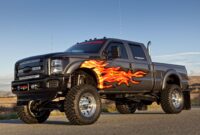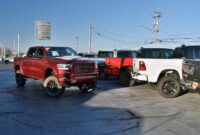The Definitive Guide to Walk Behind Reach Trucks cars.truckstrend.com
In the dynamic world of warehousing, logistics, and manufacturing, efficient space utilization is paramount. As businesses strive to maximize storage capacity within existing footprints, specialized material handling equipment becomes indispensable. Among these, the walk behind reach truck stands out as a versatile and cost-effective solution for navigating narrow aisles and reaching high shelves. This comprehensive guide will delve into every facet of walk behind reach trucks, providing a detailed understanding of their function, benefits, operational aspects, and key considerations.
What is a Walk Behind Reach Truck?
The Definitive Guide to Walk Behind Reach Trucks
A walk behind reach truck, often referred to as a pedestrian reach truck or stand-on reach truck (though the latter usually implies a small platform, for this article we focus on true walk-behind units), is a specialized piece of material handling equipment designed for vertical storage and retrieval of palletized goods in confined spaces. Unlike traditional forklifts where the operator sits, or rider reach trucks where the operator stands on an integrated platform, with a walk behind model, the operator walks behind the unit, controlling its movements via a tiller handle or ergonomic controls.
Its defining characteristic is the ability of its mast and forks to extend forward, or "reach," beyond the outriggers (stabilizing legs), allowing it to pick up or place pallets deeper into racking without the entire truck needing to enter the rack opening. This "reach" mechanism, combined with its compact chassis, makes it exceptionally adept at working in very narrow aisles (VNAs) where conventional forklifts cannot operate. Powered by an electric motor, these trucks are designed for indoor use on smooth, level surfaces, offering a clean and quiet operation essential for many modern warehouse environments.
Key Benefits and Advantages
Walk behind reach trucks offer a compelling set of advantages that make them a preferred choice for specific applications:
- Exceptional Maneuverability in Tight Spaces: This is their primary strength. Their compact design and the "reach" function allow them to operate efficiently in aisles as narrow as 8-10 feet, significantly less than what a counterbalance forklift requires. This optimizes warehouse space, allowing for more racking and therefore more storage.
- Cost-Effectiveness: Generally, walk behind reach trucks are a more affordable investment compared to their rider reach truck counterparts or full-sized forklifts, particularly for operations with moderate throughput requirements. Their electric operation also means lower fuel costs and reduced maintenance compared to internal combustion engines.
- Enhanced Operator Safety (in specific contexts): While all material handling equipment requires strict safety protocols, the walk-behind design can offer certain safety benefits. The operator has a clear view of the immediate surroundings, and the lower travel speeds inherent to walk-behind units reduce the risk of high-speed collisions. The design also often keeps the operator at a safer distance from the load during handling.
- Versatility: Many models come with adjustable forks, allowing them to handle various pallet sizes (e.g., Euro pallets, standard US pallets) with ease. They are suitable for a wide range of tasks, from general warehousing and order picking to stacking in cold storage or pharmaceutical facilities.
- Reduced Footprint: When not in use, their compact size means they occupy less floor space, contributing to a more organized and less cluttered work environment.
- Environmentally Friendly: Being electrically powered, they produce zero emissions during operation, making them ideal for indoor use, food handling, and environments sensitive to air quality. They also operate quietly, reducing noise pollution in the workplace.

Types and Configurations

While the core functionality remains consistent, walk behind reach trucks come in various configurations to suit diverse operational needs:
- Standard Walk Behind Reach Truck: The most common type, featuring a mast that extends forward to place or retrieve loads. These are highly versatile for general warehousing tasks.
- Straddle Leg Walk Behind Reach Truck: These models have wider outrigger legs that straddle the pallet, allowing the forks to get closer to the load. This design is particularly beneficial for handling wider or non-standard pallets and provides enhanced stability for heavier loads.
- Pantograph Reach Mechanism (Less Common for Pure Walk-Behind): While more typical on rider reach trucks, some advanced walk-behind models might incorporate a pantograph mechanism for deeper reach capabilities, allowing the forks to extend significantly further without the entire mast moving forward.
- Load Capacity Variations: Available in a range of capacities, typically from 2,000 lbs (1,000 kg) to 4,000 lbs (1,800 kg), though some specialized units may offer more.
- Lift Height Variations: Capable of lifting loads to considerable heights, often up to 20 feet (6 meters) or more, depending on the model and mast configuration.
- Battery Types:
- Lead-Acid Batteries: Traditional, robust, and cost-effective upfront, but require regular watering, specific charging cycles, and emit gases during charging.
- Lithium-Ion Batteries: Increasingly popular due to their longer lifespan, faster charging capabilities (opportunity charging), no maintenance, and higher energy efficiency. While more expensive initially, they often offer a lower total cost of ownership over time.

Operating a Walk Behind Reach Truck: A Basic Guide
Operating a walk behind reach truck requires proper training and adherence to safety protocols. Here’s a basic overview of the operational process:
- Pre-Operation Checks: Before each shift, perform a thorough inspection. Check the battery charge, ensure all controls (lift, lower, reach, retract, horn) are functioning, verify the brakes are operational, inspect forks for damage, and check tire condition.
- Approach the Load: Walk behind the truck, using the tiller handle to steer. Approach the pallet squarely, ensuring the outriggers are positioned correctly to straddle the pallet or be positioned safely around it.
- Engage the Load: Carefully drive the truck forward until the forks are fully under the pallet. Use the lift control to raise the forks slightly, just enough to clear the floor.
- Retract the Load: Use the "retract" or "pull-in" control to bring the load fully back towards the mast, within the footprint of the truck’s outriggers. This ensures maximum stability during travel.
- Travel Safely: Lower the load to the lowest possible travel height (typically 4-6 inches off the ground) for stability and clear visibility. Maintain a safe speed, be aware of your surroundings, and always look in the direction of travel. Use the horn at intersections or blind spots.
- Place the Load: Approach the racking squarely. Once aligned, use the "reach" control to extend the forks forward into the rack opening. Carefully raise the load to the desired height, ensure it’s fully seated on the beams, then lower the forks until they are free.
- Retract and Back Away: Once the load is placed, retract the forks fully back towards the mast. Then, slowly back the truck away from the rack.
- Post-Operation: Park the truck in its designated charging area, engage the brake, and connect it to the charger if needed. Report any issues or damage immediately.
Crucial Advice: Always follow the manufacturer’s operating manual. Operator training and certification are mandatory and vital for safe and efficient operation. Never overload the truck, and always ensure loads are stable and properly secured.
Important Considerations Before Purchase/Deployment
Choosing the right walk behind reach truck involves several critical factors to ensure it meets your operational demands:
- Warehouse Layout and Aisle Width: This is paramount. Measure your narrowest aisle to ensure the truck’s dimensions (especially with a load) can maneuver safely. Consider ceiling heights for maximum lift capabilities.
- Load Characteristics: Analyze the typical weight, dimensions, and stability of the pallets you will be handling. This will dictate the required load capacity and lift height of the truck.
- Throughput Requirements: How many pallets do you need to move per hour or per shift? While efficient, walk behind trucks have lower travel speeds than rider models, which might impact high-volume operations.
- Operator Skill and Training: Ensure your operators are fully trained and certified. The ergonomics and controls of a walk behind unit differ from other equipment.
- Maintenance and Servicing: Consider the availability of parts and service support from the dealer. Factor in routine maintenance, especially battery care for lead-acid models.
- Budget: Balance the upfront purchase price with long-term operating costs, including battery replacement, maintenance, and energy consumption.
- Floor Condition: Walk behind reach trucks perform best on smooth, level, and clean concrete floors. Uneven surfaces can affect stability and cause premature wear.
- Environmental Conditions: If operating in cold storage, ensure the truck is specified for low temperatures. For dusty environments, consider sealed components.
Challenges and Solutions
While highly beneficial, walk behind reach trucks do present some challenges:
- Limited Travel Speed: They are not designed for long-distance horizontal transport.
- Solution: Use them in conjunction with electric pallet jacks or rider forklifts for transporting loads over longer distances within the warehouse.
- Operator Fatigue on Long Shifts: Walking behind the truck for extended periods can lead to fatigue, especially in large operations.
- Solution: Implement job rotation, provide adequate breaks, and invest in models with ergonomic tiller handles and controls that reduce strain.
- Visibility Issues (when reaching high): When placing or retrieving loads at extreme heights, the operator’s ground-level perspective can sometimes limit visibility of the fork tips.
- Solution: Strict safety protocols, including using a spotter for very high lifts, ensuring proper lighting, and some advanced models may offer optional camera systems for better visibility.
- Battery Life Management: For lead-acid batteries, improper charging or maintenance can shorten lifespan and reduce uptime.
- Solution: Adhere to proper charging cycles, ensure regular watering for lead-acid batteries, consider battery monitoring systems, or invest in lithium-ion batteries for maintenance-free and faster charging benefits.
- Load Stability: Improperly loaded or unstable pallets can pose a risk, especially when lifting to heights.
- Solution: Thorough training on load securing and stability principles, ensuring pallets are correctly wrapped or banded, and never exceeding the truck’s rated capacity.
Estimated Price Guide: Walk Behind Reach Trucks
The price of a walk behind reach truck can vary significantly based on brand, load capacity, lift height, battery type, features, and whether it’s new or used. The table below provides estimated price ranges for new models. These figures are illustrative and a formal quote from a supplier is always recommended.
| Feature / Model Type | Load Capacity (lbs/kg) | Max Lift Height (ft/m) | Battery Type | Key Features (Typical) | Estimated Price Range (USD) |
|---|---|---|---|---|---|
| Entry-Level | 2,200 lbs (1,000 kg) | 10-13 ft (3-4 m) | Lead-Acid | Basic controls, compact, simple mast | $10,000 – $18,000 |
| Standard Duty | 2,500-3,000 lbs (1,130-1,360 kg) | 16-20 ft (5-6 m) | Lead-Acid | Ergonomic tiller, basic safety features, adjustable forks | $18,000 – $28,000 |
| Heavy Duty / High Lift | 3,300-4,000 lbs (1,500-1,800 kg) | 20-25 ft (6-7.5 m) | Lead-Acid / Li-ion (option) | Advanced controls, robust mast, higher travel speeds, better stability | $28,000 – $45,000+ |
| Premium / Lithium-ion | 3,000-4,000 lbs (1,360-1,800 kg) | 16-25 ft (5-7.5 m) | Lithium-Ion | Opportunity charging, longer lifespan, maintenance-free, advanced diagnostics | $35,000 – $60,000+ |
Disclaimer: These prices are estimates for new equipment and do not include shipping, taxes, optional accessories (e.g., side shift, camera systems), or ongoing maintenance costs. Used models can be significantly cheaper, but their condition and remaining lifespan must be thoroughly assessed. Always obtain multiple quotes from reputable dealers for accurate pricing.
Frequently Asked Questions (FAQ)
Q1: What’s the main difference between a walk behind and a rider reach truck?
A1: The primary difference is the operator’s position. With a walk behind, the operator walks behind the truck, controlling it via a tiller handle. A rider reach truck has a platform or cabin where the operator stands or sits. Rider trucks generally offer higher lift capacities, faster travel speeds, and are better suited for larger warehouses with longer travel distances.
Q2: Are walk behind reach trucks difficult to operate?
A2: No, they are relatively intuitive to operate, especially for those familiar with pallet jacks. However, proper training and certification are essential due to the "reach" function and high lifting capabilities. Practice is key to mastering precise movements.
Q3: What safety precautions should be taken when operating a walk behind reach truck?
A3: Always wear appropriate PPE (safety shoes, high-visibility clothing), conduct pre-operation checks, ensure a clear path of travel, maintain safe speeds, never overload the truck, keep clear of the mast and moving parts, and always be aware of your surroundings.
Q4: How often do walk behind reach trucks need maintenance?
A4: Regular maintenance is crucial. This typically includes daily visual checks, weekly battery checks (for lead-acid), and scheduled professional servicing every 250-500 operating hours or quarterly, depending on usage and manufacturer recommendations.
Q5: Can walk behind reach trucks be used outdoors?
A5: Generally, no. Walk behind reach trucks are designed for indoor use on smooth, level, and dry surfaces. Their electric components are not typically weather-sealed, and uneven outdoor terrain can compromise stability and cause damage.
Q6: What’s the typical lifespan of a walk behind reach truck?
A6: With proper maintenance and regular use, a walk behind reach truck can last 10-15 years or more. Battery life varies, with lead-acid batteries lasting 3-5 years and lithium-ion batteries often exceeding 8-10 years.
Q7: Is specific licensing or certification required to operate a walk behind reach truck?
A7: Yes, in most regions, operators must be trained and certified to operate any powered industrial truck, including walk behind reach trucks. This ensures operators understand safe operating procedures, load handling, and emergency protocols.
Conclusion
The walk behind reach truck is an invaluable asset for businesses aiming to optimize their storage space and improve operational efficiency in narrow aisle environments. Its blend of compact design, impressive lift capabilities, and cost-effectiveness makes it a compelling choice for a wide array of industries. By understanding its core functions, benefits, operational best practices, and key considerations for deployment, businesses can leverage this versatile machine to unlock significant productivity gains.
Ultimately, the successful integration of a walk behind reach truck hinges on a careful assessment of specific operational needs, a commitment to proper operator training and safety protocols, and diligent maintenance. When selected and utilized correctly, these unassuming workhorses prove to be powerful contributors to a streamlined, safe, and efficient material handling operation.



